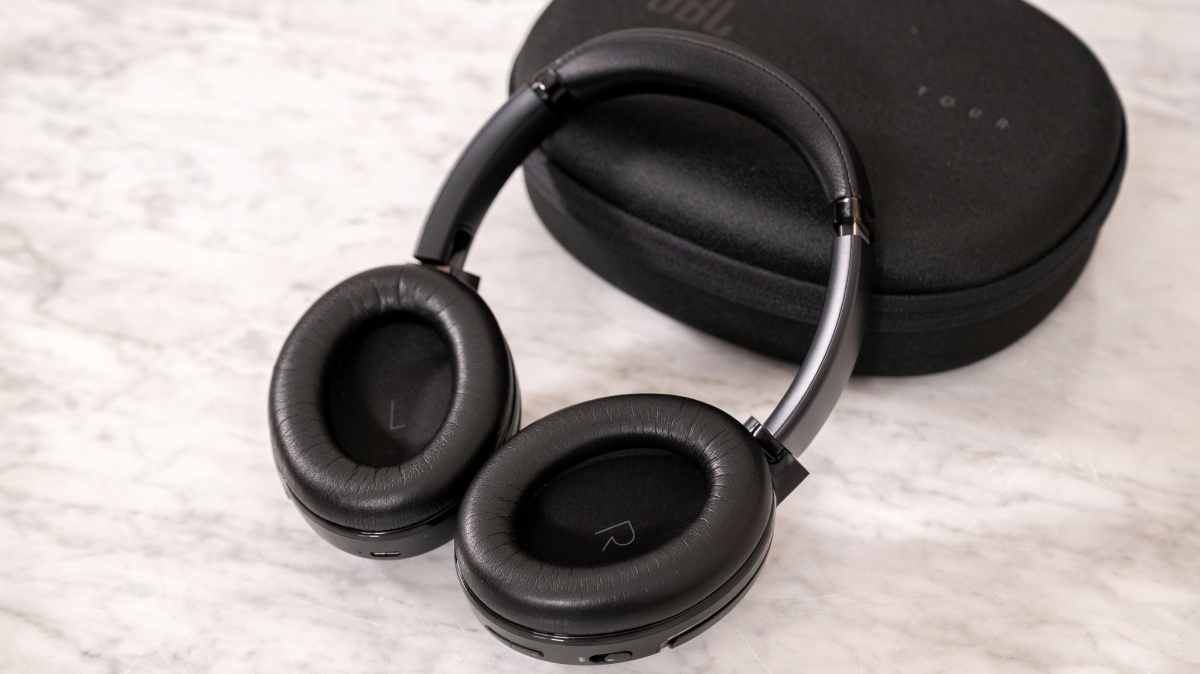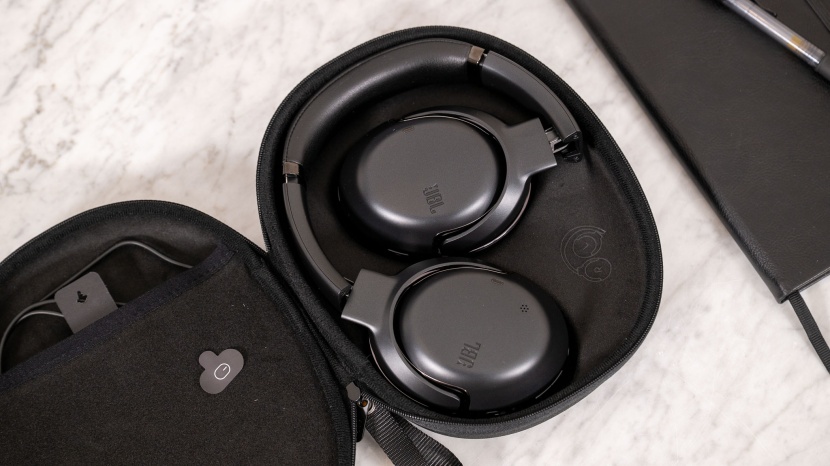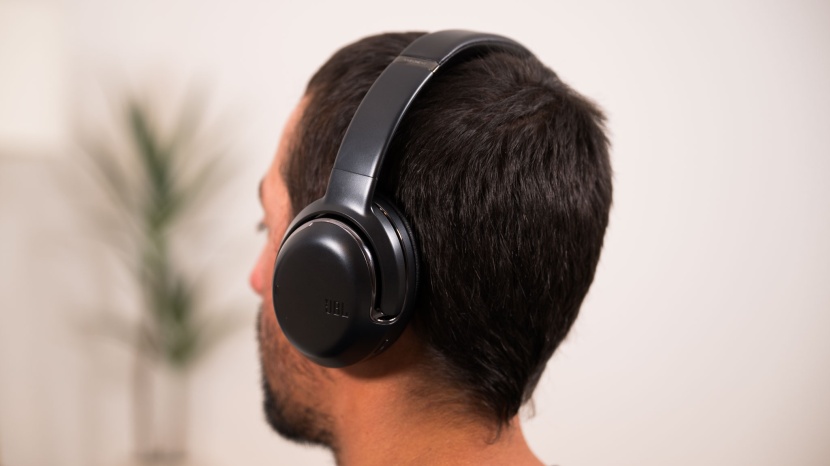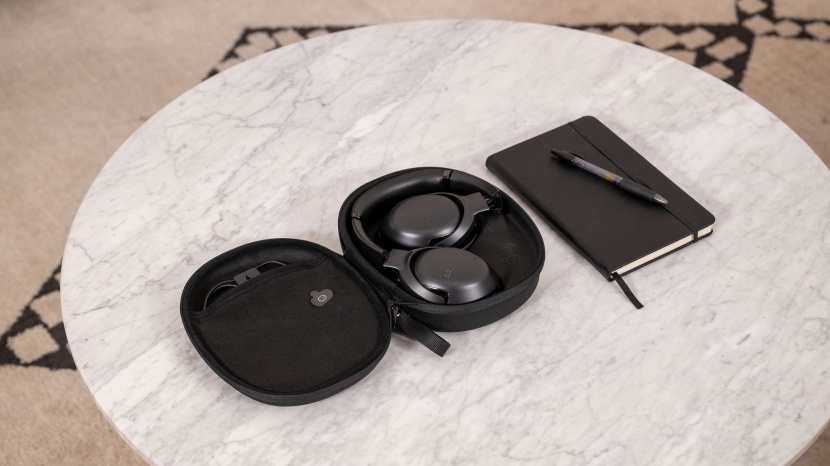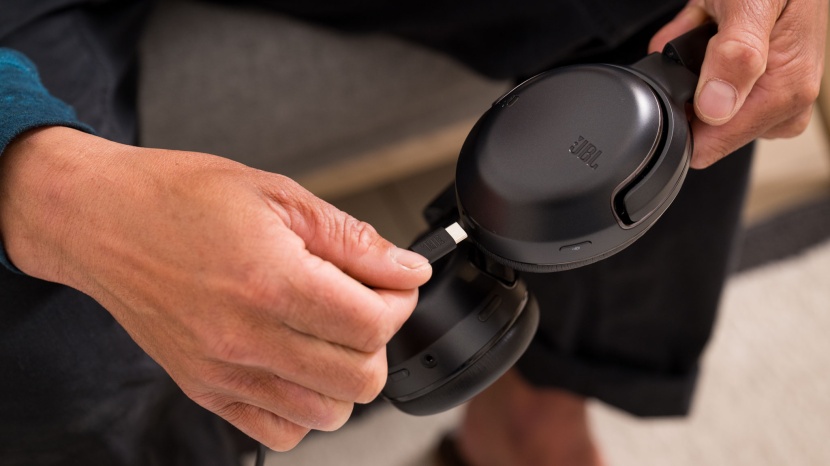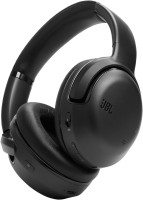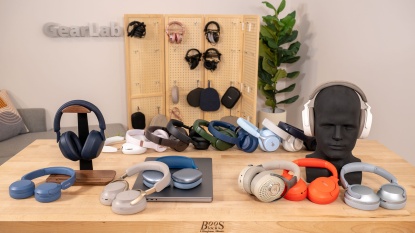
Our Verdict
Our Analysis and Test Results
Our JBL Tour One M2 Headphones Experience
JBL is known for audio, and there is much hype surrounding the Tour One, but it failed to match our expectations. Right out of the box, these headphones had a strong odor. They continued to give off a strong odor for months after opening. Worse still, they imparted this smell to skin and clothing they spent time near. We kept expecting the smell to disappear or improve, but months later it is still offensive and not worth the patience involved in “getting used to it.”
The JBL wirelessly connects up to two devices via Bluetooth. Whether connecting to an Apple or Android, we didn't experience any connectivity problems. We wish the headphones automatically switched audio between the two connected devices, so we could swap between a laptop and phone more seamlessly. Still, switching between devices is easy enough in the app.
Our ears were sore, sweaty, and overworked. Thin padding can cause sensitive pressure points on the ears and headband, making it even more uncomfortable for those who wear glasses or earrings. Plus, despite the strong clamping force, the headphones easily slide around with moderate head movements, making them a poor choice for working out. Additionally, the lingering off-gassing made our faces and hair smell long after the headphones were removed.
During live phone calls, the voice quality of Tour One was outstanding for both participants. We appreciated the ability to adjust the volume of our own voices because not hearing one's own voice can be disorienting for some.
JBL's transparency mode was disappointing; it was robotic, unpleasant, and artificial. It has a loud, synthetic quality that is off-putting. The Personal Sound Amplification slider allowed us to adjust the volume to a more comfortable level of awareness, but it didn't fix the artificial sound. We wouldn't suggest these headphones for staying aware in public spaces.
Sound Quality
After testing dozens of wireless headphones side by side, the Tour One M2's sound is among the worst. Even cheaper budget competitors outperform it. There is better audio quality on the market for far less money.
For casual listeners, the sound is punchy and decent enough, but critical ears will immediately notice the lack of detail, clarity, and power. We described it as the audio equivalent of astigmatism; everything's there, but slightly out of focus. We listened a few notches above the midline to get adequate volume, when typically the midline is the sweet spot. Any lower, and the bass fades away and gets lost in the mix.
The overall mix is sculpted, leaning towards that ever-so-popular fun, bass-heavy sound that plays well with pop, rock, dance, alternative, and hip-hop genres. However, the bass and treble are inconsistent in their delivery, which can result in distortion. The lows sounded muddied in percussion-driven hop-hop tracks like “Lo Tengo” by Trueno & JID, but swelled in more poppy synth tracks like “Hometown Girl” by Zhu. Likewise, the highs fluctuated from sounding glistening to glaring to masked, basically the full range of expression. The M2's redeeming quality is that the mids, like vocals, have decent clarity and are consistent. They remain present, even in bass-heavy songs.
Relative to our in-house Target Response curve, which portrays what we think is the ideal balance, the M2 frequency response curve has elevated lows and erratic highs.
What does this mean? The bass comes across as bold and dramatic, providing a thumpy, head-bobbing feel. The highs are more temperamental, sometimes underwhelming, and at other times overpowering. The profile is adjustable in the app, but none of the adjustments improved the sound.
Soundstage
The M2s don't feel very immersive. The audio lacks height and depth, sounding as if it's being funneled into your ears from a pinpoint.
There's no mistaking you're listening to tiny speakers, not a live performance. Listening to music with the JBL Tour is like chilling in a boxy shed with some dusty windows. It needs more detail to sound real and inspiring.
Comfort and Fit
The thin padding, strong clamping force, and heat-trapping material limit total wear time.
Thirty minutes was the average wear time in our tests, though one listening adventurer made it reluctantly to four hours.
Noise Cancellation
The Tour One M2 have active noise cancelling (ANC) capabilities, and it is effective at dampening ambient sounds, but it doesn't fully block them out.
The M2's ANC primarily works in the bass and mid-frequency range, where common urban sounds like traffic and chatter occur. With the ANC on, we barely heard keyboard clacking and others talking.
High-pitch sounds, such as microwave beeps and clanky dishes, came through louder, which is not surprising since ANC isn't entirely effective in this range. Instead, the padding and materials' passive sound-isolating properties offer relief for high-hitting annoyances.
App and Controls
The JBL Headphones App is packed with useful features. Spatial audio promises a three-dimensional listening experience, while the PersoniFi-2.0 test offers a customized sound based on your personal hearing preferences. Unfortunately, the hearing test, adjustable equalizer (EQ), and presets didn't noticeably improve the sound quality.
The app also features nifty enhancements, including a volume limiter to ensure safe listening, head detection to pause the music when headphones are removed, and Smart Talk, which automatically mutes the sound when you speak. Additionally, the noise-cancelling and awareness modes are fully customizable, allowing a precise amount of ambient sound to be chosen. We weren't impressed with the authenticity of the Ambient Sound mode. Every feature you could want is here, but they aren't that effective.
Controls
The button and touch controls are easy to use, but they're pretty sensitive and somewhat finicky. They randomly pause music or skip a track after subtle movements, such as brushing the earcup too close to the shoulder.
Battery
JBL's listed battery life is 30 hours with the ANC on, but we measured 45.5 hours. This is impressive, as ANC tends to drain the battery quickly; most ANC-supporting headphones have a battery life of 20-30 hours, making 45.5 hours one of the longest.
These headphones also support passive playback, allowing you to continue listening even if your battery dies, simply by plugging in the included audio cable.
Call Quality
While the M2 disappoints in most ways, it excels in one key area: making phone calls. Whether calling from a quiet, private space or a noisy public setting, voices sound clear with very limited interference.
The subway test is the most challenging. It measures how well the microphones and software can distinguish your voice from all the background noise. The background subway whirs and loudspeaker announcements are nearly inaudible, and the caller's voice remains loud and easy to understand. The office test is less aggressive. The M2 impresses here, removing almost all background noise with no voice distortion.
The baseline test provides an indication of voice quality in a quiet, controlled environment. Without background interference, voices are clear, with a hint of fuzz.
| Awards | |
|---|---|
| Price | $330 List Check Price at Amazon |
Overall Score  |
|
| Star Rating | |
| Bottom Line | Clear calls, but the disappointing audio and fit don't live up to the hype |
| Pros | Excellent calling, user-friendly app |
| Cons | Subpar sound, uncomfortable, finicky controls, strong smell |
| Rating Categories | JBL Tour One M2 |
| Sound Quality (35%) | |
| Comfort (25%) | |
| Noise Cancellation (20%) | |
| App & Controls (10%) | |
| Call Quality (10%) | |
| Specifications | JBL Tour One M2 |
| Comfortable Listening Hours | 2.5 hrs |
| Claimed Battery Life | 50 hrs |
| Wearing Detection | Yes |
| Multipoint | Yes |
| Measured Weight | 279 g |
| Measured Maximum Connectivity Distance | 149 ft |
| Measured Ear Cup Size | 58 mm H x 39 mm W |
| EQ Customization | Yes |
| Driver Size | 40 mm |
| Passive Playback | Yes |
| Spatial Audio | Yes |
| Active Noise Cancelling | Yes |
| Transparent Mode | Yes |
| Connectivity Options | AAC, SBC |
| Carrying Case | Yes |
| Included Cords | -2.5 to 3.5 mm audio cable -USB x Type-C charging cable |


